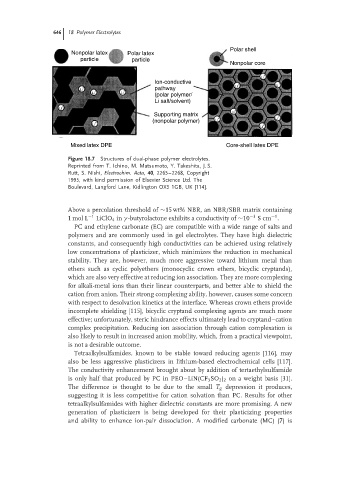Page 672 - Handbook of Battery Materials
P. 672
646 18 Polymer Electrolytes
Polar shell
Nonpolar latex Polar latex
particle particle
Nonpolar core
+
Li
Ion-conductive + +
+ pathway Li Li
Li + +
Li Li
(polar polymer/
Li salt/solvent)
+
Li +
Supporting matrix + Li +
+ (nonpolar polymer) Li Li
Li +
Li
Mixed latex DPE Core-shell latex DPE
Figure 18.7 Structures of dual-phase polymer electrolytes.
Reprinted from T. Ichino, M. Matsumoto, Y. Takeshita, J. S.
Rutt, S. Nishi, Electrochim. Acta, 40, 2265–2268, Copyright
1995, with kind permission of Elsevier Science Ltd. The
Boulevard, Langford Lane, Kidlington OX5 1GB, UK [114].
Above a percolation threshold of ∼15 wt% NBR, an NBR/SBR matrix containing
−1
1 mol L −1 LiClO 4 in γ -butyrolactone exhibits a conductivity of ∼10 −3 Scm .
PC and ethylene carbonate (EC) are compatible with a wide range of salts and
polymers and are commonly used in gel electrolytes. They have high dielectric
constants, and consequently high conductivities can be achieved using relatively
low concentrations of plasticizer, which minimizes the reduction in mechanical
stability. They are, however, much more aggressive toward lithium metal than
ethers such as cyclic polyethers (monocyclic crown ethers, bicyclic cryptands),
which are also very effective at reducing ion association. They are more complexing
for alkali-metal ions than their linear counterparts, and better able to shield the
cation from anion. Their strong complexing ability, however, causes some concern
with respect to desolvation kinetics at the interface. Whereas crown ethers provide
incomplete shielding [115], bicyclic cryptand complexing agents are much more
effective; unfortunately, steric hindrance effects ultimately lead to cryptand–cation
complex precipitation. Reducing ion association through cation complexation is
also likely to result in increased anion mobility, which, from a practical viewpoint,
is not a desirable outcome.
Tetraalkylsulfamides, known to be stable toward reducing agents [116], may
also be less aggressive plasticizers in lithium-based electrochemical cells [117].
The conductivity enhancement brought about by addition of tertaethylsulfamide
is only half that produced by PC in PEO–LiN(CF 3 SO 2 ) 2 on a weight basis [31].
The difference is thought to be due to the small T g depression it produces,
suggesting it is less competitive for cation solvation than PC. Results for other
tetraalkylsulfamides with higher dielectric constants are more promising. A new
generation of plasticizers is being developed for their plasticizing properties
and ability to enhance ion-pair dissociation. A modified carbonate (MC) (7)is

